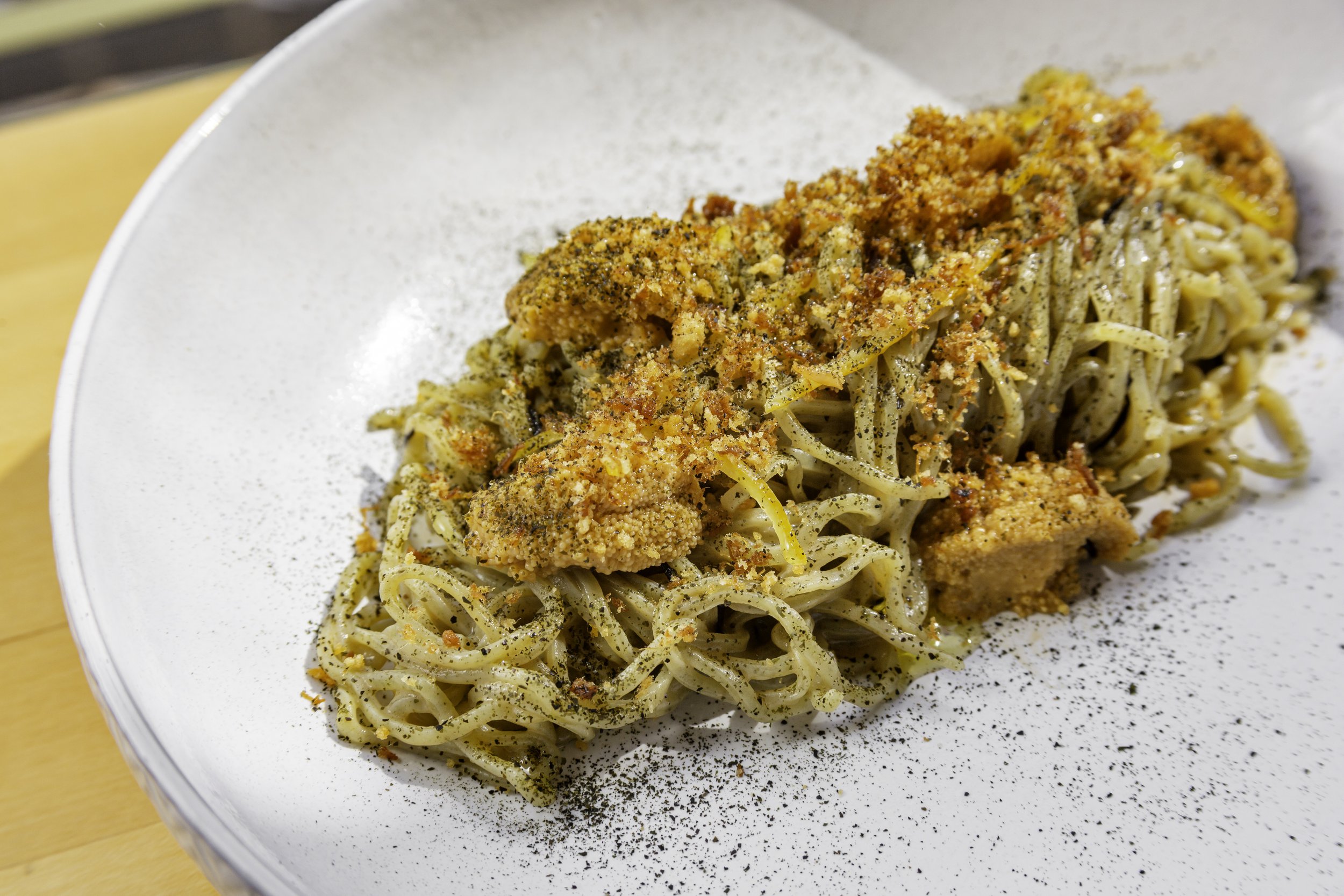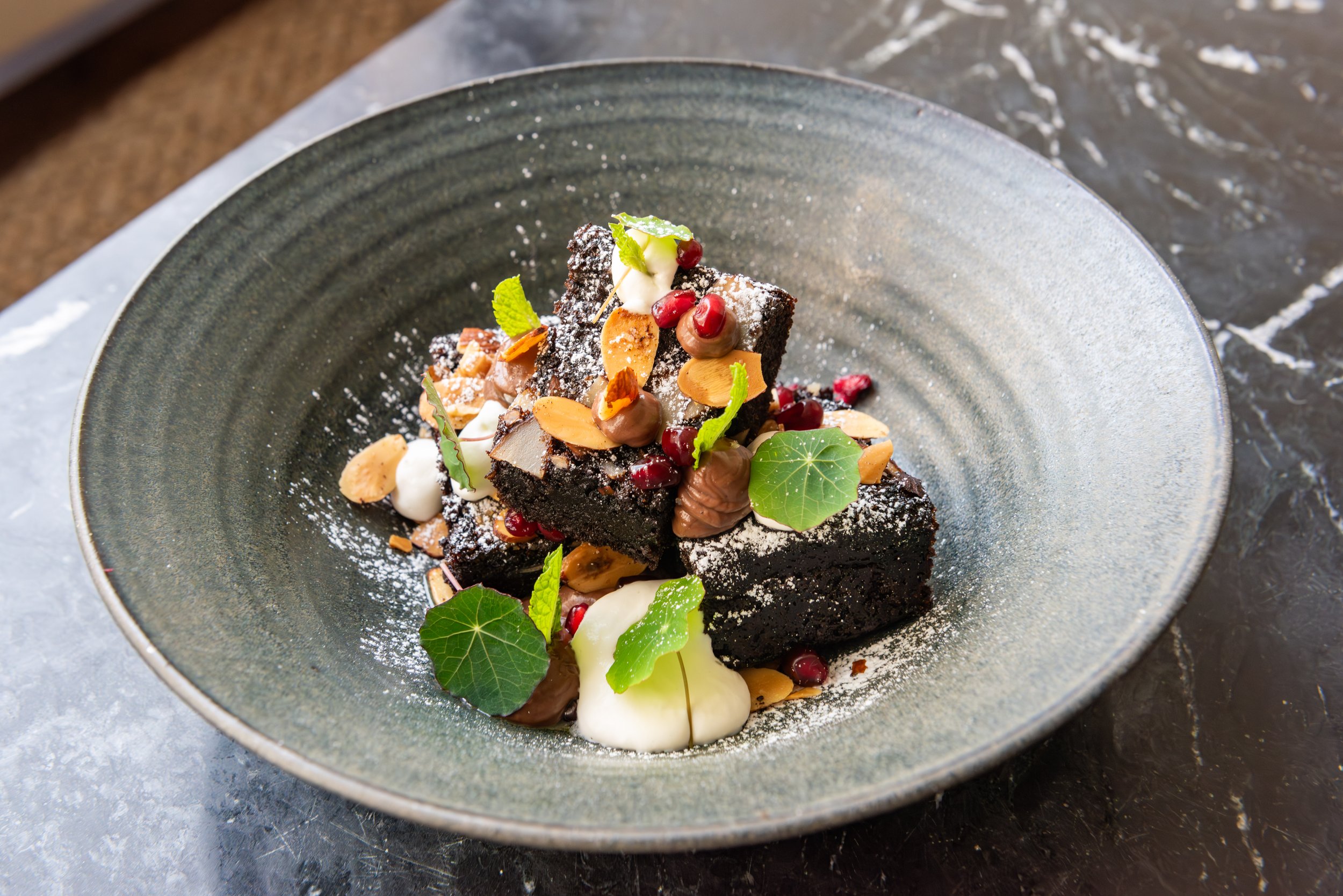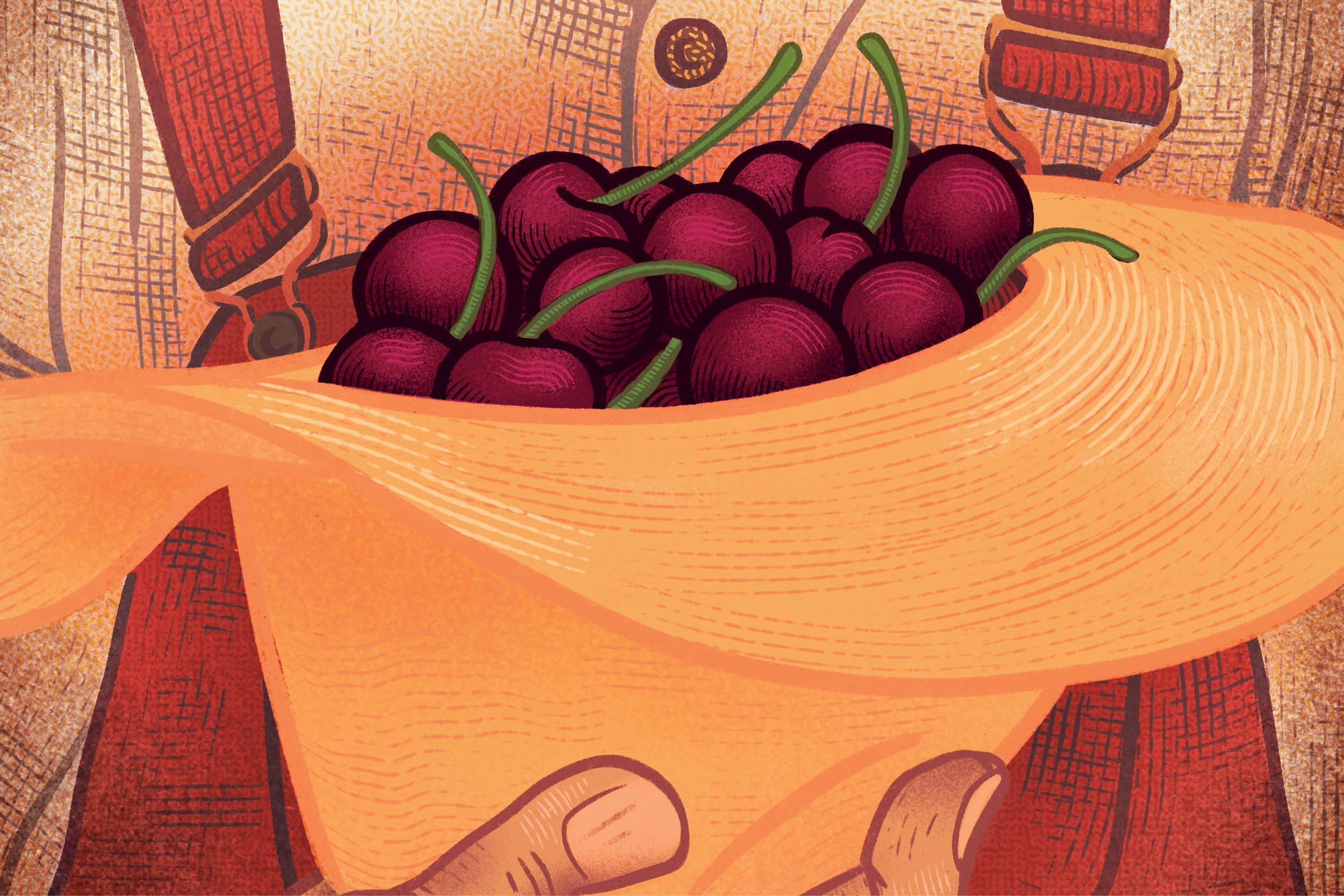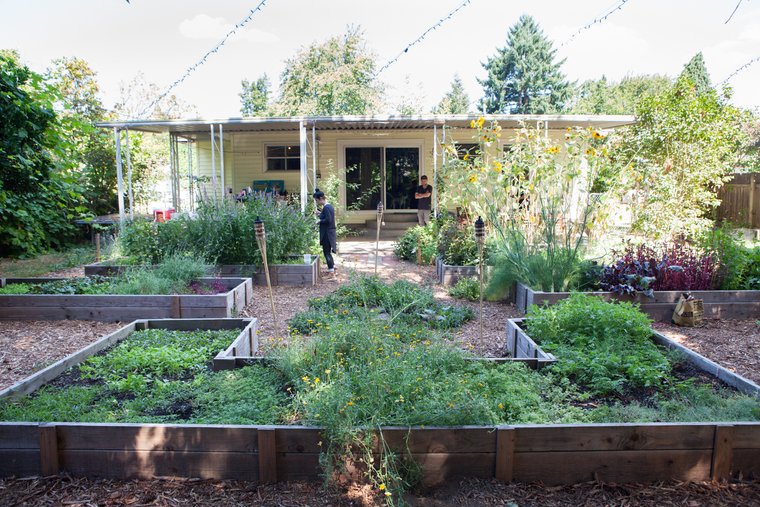Of Kelp and Kitchens
New England chefs are forging relationships with sea vegetables (and the folks that farm them).
On a cold, stormy day in March 2021 in the Casco Bay, just off Freeport, Maine, Chef Jeremy Broucek was trying to hook a submerged line with a long pole hook while attempting to keep his balance on a small boat’s icy deck. Thanks to 30-knot winds, he missed grabbing the line laden with long strands of kelp the first few times the boat whipped by.
White-capped waves, a strong current, and the wind were also making it difficult for Ken Sparta of Spartan Sea Farms to get the boat safely in position. Sparta was taking Broucek, co-owner and chef at Bread & Friends in Portland, to harvest skinny kelp for a new product he wanted to develop for his young business: kelp butter.
Broucek finally managed to snag the rope, and they tied off just long enough to harvest two five-gallon buckets of kelp without falling into the ocean.
Grilled Oysters, Kelp Butter, Pickled Green Apple, Shirodashi Tapioca Pearls
Kelp, It Does a Body Good
These kinds of direct connections between chefs and sea vegetable growers are helping to drive the increasing appearance of seaweed on menus across the country. In 2019, the U.S. produced around 3,394 tons of wet weight kelp, both farmed and wild harvested according to the United Nations Food and Agriculture Organization. About 85% of the country’s kelp production in 2021 came from Maine. As production has grown in Maine over the last five years, so has interest from chefs across New England for including seaweed on their menus.
For chefs like Broucek, the opportunity to meet food producers where they work not only builds trust, it also helps write the story of the food they create for their customers. “Any time I can go out and spend time with a farmer and see what is involved in the growing and sourcing of that ingredient really makes a big difference to me,” Broucek said.
Broucek is one of an increasing number of chefs across the country that are embracing different types of sea vegetables as opportunities to expand their creativity, offer more climate-conscious items to customers, and educate folks about kelp’s nutritional benefits.
Chef Billy Hager and others on the team at Helm Oyster Bar & Bistro in Portland recently took a “field trip” with Sparta out on his boat to tour both kelp and oyster farms in Casco Bay. After he moved to Maine four years ago, Hager noticed quite a change in how supportive and accessible the kelp farming industry was compared to his home state of California.
“There’s a tighter knit community here in Maine, and a lot more seaweed that’s available locally,” he said. “Late spring and early summer is the season for sugar kelp, and farmers like Ken are introducing chefs to it.”
Kelp Ice Cream, Spoonbill Caviar, Olive Oil, Lemon Zest
Soft Serve Swirl: Sea Salt Vanilla and Chocolate-Sugar Kelp
Since Helm opened in 2021, Hager and his crew have used sugar kelp in a wide range of delicious ways, including as a garnish, in stocks, or in sauces and spice blends. This summer he bought five pounds of dried sugar kelp, which he describes as “a bit like kombu with a little bit of salinity and minerality.” He and his team rolled tuna in a fine ground sugar kelp powder and served it as a crudo. They’ve also used it with a ham broth to steam mussels.
And they’ve used it to make kelp ice cream, which delivers hints of the ocean's salinity to balance out the sweet cream. During Maine’s Seaweed Week in late April, he created a Caviar Sundae featuring kelp ice cream, Spoonbill caviar, olive oil, and lemon zest.
In fact, kelp in ice cream is finding a home in other locations, including Fish & Whistle in Biddeford, where Chefs Kate Hamm and Jason Eckerson have offered customers a soft serve swirl with sea salt vanilla and chocolate-sugar kelp ice cream. “[Ice cream] is a great vehicle,” says Hamm. “People are just curious to try it.”
Like Hager, she sees the value in building community with producers to expand people’s palates. “The more people are familiar with things like seaweed, the more they’ll buy it at the store,” she said. “We can show them that these things are delicious.”
Journey of Discovery
Part of the excitement that chefs have for working with sea vegetables is the discovery phase. That was certainly the case for Chef Valerie Goldman at The Honey Paw in Portland. One of her recent signature kelp dishes was Kelp Spaghetti alla Chitarra, featuring uni, local nori powder, pork floss, and Hijiki.
Finding the right ratio of dried kelp powder (from Atlantic Sea Farms) to the noodle dough was the biggest challenge. “That was an interesting journey,” she said. “Kelp powder has such a thickening quality.” She and her team spent about a week trying around eight to ten different versions to get the right consistency, color, and flavor.
Bartenders like Rachel Stone at Oberlin in Providence are also increasingly upping their game by testing new kelp concoctions. Inspired by the classic gimlet, Stone’s Reef Keeper cocktail uses seaweed-infused gin and a seaweed cordial.
“The briny, oceanic flavor complements the different dishes on our menu,” she said. “It's a familiar, nostalgic flavor that can be transportive as it reminds us of our precious summer season in New England.”
Kelp Spaghetti alla Chitarra: Uni, Local Nori Powder, Uni Dashi Miso Sauce, Preserved Lemon, Pork Floss, Lemon Breadcrumbs, Hijiki
Reef Keeper: Seaweed-Infused ISCO Gin, Seaweed Syrup, Lime Cordial, Lime Juice, Puffed Rice Nori Chip
Buy Local, Eat Local
Everyone acknowledged that sourcing local seaweed benefits the local economy. Growing seaweed is becoming a wintertime revenue stream for some Maine fish and lobster harvesters who otherwise might not be on the water during their off season. And when their products are harvested, bought, and sold in the same region, the entire community, from harvesters to consumers, benefits.
Severine Von Tscharner Fleming manages Smithereen Farm in Pembroke, where she recently hosted a community dinner and “low low tides” workshop with Chef Evan Mallet of Black Trumpet in Portsmouth, New Hampshire. The event was aimed at educating folks about the local kelp crop and how it can be used in the kitchen.
While feasting on lobster tamales wrapped in kelp and deep-fried green crabs dusted with sumac and seaweed, attendees learned about the importance of ensuring that seaweed and bivalve aquaculture remain in balance with local ecosystems. Some sea farmers and chefs fear that if the industry grows so rapidly, it could attract industrial-scale operations, which means local estuaries and bays could suffer ecologically.
“Increasingly, I have concerns of domestication of kelp and growing it on too large a scale,” Fleming said. “Kelp is not the new kale. Let’s grow it as a specialty food, not as a bulking agent.”
Whether infused in butter, pasta, ice cream, gin, or another delicacy, seaweed will show up on more restaurant menus as chefs continue working with local producers to create flavorful dishes and drinks that tell the story of where the seaweed is from and why we should want to eat it.
Sparta agrees that getting chefs on boats is crucial to growing the market here in Maine and beyond. “For them, seeing food as it’s being grown and seeing what we do to bring it to the table…that connects them more with the process, and in turn how they connect to their customers.”










